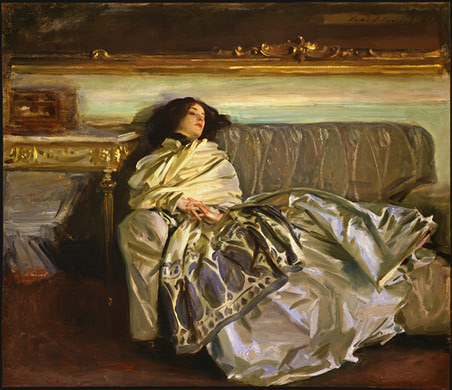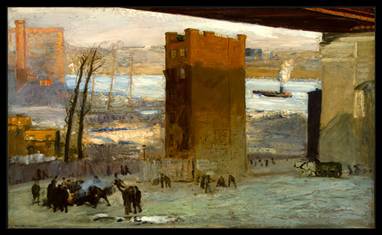
Back to Spring 2006 English Syllabus
Multimedia Project 1 - The Gilded Age/How the Other Half Lives
 |
John
Singer Sargent, Nonchaloir (Repose) (1911) oil on canvas, 63.8 x 76.2 cm (25 1/8 x 30 in.) The National Gallery of Art, Gift of Curt H. Reisinger |
With
the publication of his 1873 novel, The Gilded Age, Mark Twain
critiqued the late nineteenth century as an era when America’s
glittering surface masked economic and political corruption. The rich
filled their lives with “conspicuous consumption,” a term
coined in 1902 by Thorstein Veblen in his economic treatise The
Theory of the Leisure Class.
Just beneath the unimaginable wealth of the few, however, existed another world of immigrant hopes, overcrowded living conditions, and daily struggles for survival. Jacob Riis exposed the larger reality of How the Other Half Lives in 1890 when his book both textually and visually cried out for social reform. For your first short web project you will find and interpret an image relating to the theme of “The Gilded Age/How the Other Half Lives.”
For your first project consider the following:
• Begin by finding an image of your work of art. You will need to include in your page the title of your painting or photograph, the date of completion, the artist, the life dates of the artist, the medium (for example, oil on canvas), and the dimensions of the work.
• Content! Content! Content! In addition to your image, your page should contain 300 - 400 words of prose. The most attractive website is ineffective if it doesn’t provide clear, informative content.
Your page should include:
Description – Most of you have never written about a work of art, but all of you can describe what you see. We’ll be talking about this more in class.
Historical Information – Your reader would appreciate some historical context about the subject matter of the work, the artist, or any important events that may have influenced the work. You must decide what your viewer would find most interesting.
Interpretation – You can give your reader your own interpretation of the work. What do you think the artist wants the viewer to see? Does the artist have a particular point of view toward the subject matter? Is the artist making an argument? You are free here to make any interpretation or associations that you feel are important. There is not a formulaic answer here. We have so many different examples of art and photography to consider.
• In-text parenthetical citations for any material you paraphrase or quote directly.
• An acknowledgement of your sources for the image and any additional research
At the bottom of your page, in MLA format, in alphabetical order. See Tips for Citing Electronic Resources.
Feel free to be creative in your presentation of the information. Consider your classmates your audience, that is, someone intelligent and curious, who is not already familiar with the image, and who appreciates clear, direct prose. Your job is both to inform your viewer and to offer an interpretation of the image in a clear and interesting way.
 |
George
Bellows, The Lone Tenement (1909) oil on canvas, 91.8 x 122.3 cm (36 1/8 x 48 1/8 in.) The National Gallery of Art, Chester Dale Collection |
Project Checklist:
- Original title for your page
- Image, title (paintings & photographs are italicized), artist, year of execution, dimensions
- 300-400 words of text that include description, historical context, and interpretation
- In-text parenthetical citations for all material either paraphrased or directly quoted
- Acknowledgement of sources at the bottom of your page in MLA format
Tech checklist:
- At least 2 additional images (your painting/photograph and 2 others)
- Page name that reflects your project
- Link from your menu page to the project and from the project back to the menu page
- At least 2 pages with navigation between pages
- Alt tags for images
- At least 2 thumbnails
Project 1: The Gilded Age/How the Other Half Lives
Paintings
1. William Merritt Chase, Idle Hours, 1894
2. John Singer Sargent, Mrs. Joshua Montgomery Sears (Sarah Choate Sears), 1899
3. John Singer Sargent, Carnation, Lily, Lily Rose, 1878
4. John Singer Sargent, Daughters of Edward Darley Boit, 1892
5. Louis Comfort Tiffany, A Wooded Landscape, ca. 1905
6. Louis Comfort Tiffany, Feeding the Flamingoes, (Leaded Glass), c. 1892
7. Mary Cassatt, In the Loge, 1879
8. Mary Cassatt, The Loge, 1882
9. George Bellows, Stag at Sharkey’s, 1909
10. George Bellows, A Day in June, 1913
11. George Bellows, New York, 1911
12. Everett Shinn, Eviction, 1904
13. William Glackens, Skating in Central Park, ca.1910
14. Cecilia Beaux, The Dreamer, 1894
15. Cecilia Beaux, Ernesta (Child with Nurse), 1894
16. Edmund Charles Tarbell, Mother and Mary, 1922
Photographs
17. Gertrude Kasebier, Mrs Phillip Lydig, 1905
18. Gertrude Kasebier, A Christmas Scene, 1904
19. Frank Eugene, Minuet, 1910
20. Julia Margaret Cameron, Julia Jackson, 1864/65
21. Julia Margaret Cameron, Mrs. Herbert Duckworth, April 1867
22. Julia Margaret Cameron, Sadness, 1864
23. Jacob Riis, Home of an Italian Ragpicker, 1888
24. Jacob Riis, Mullen's Alley, Cherry Hill, 1888
25. Jacob Riis, Bandit’s Roost, 1890
26. Alfred Stieglitz, The Terminal, New York, 1892
27. Alfred Stieglitz, In the New York Central Yards, 1905
28. Alfred Stieglitz, The City of Ambition, 1910
29. Alvin Langdon Coburn, California, ca. 1911
30. Alvin Langdon Coburn, Long Beach California, 1911
31. Lewis Hine, Carolina Cotton Mill, 1908
32. Lewis Hine, Climbing into America, Ellis Island, New York, 1906
33. Lewis Hine, Young Russian Jewess, Ellis Island, New York, 1905
34. W.E. Dassonville, Portrait of A. L. Coburn, ca. 1900
35. W.E. Dassonville, Tree Along Coast, ca. 1925
Reproduction of paintings:
John Singer Sargent. Nonchaloir (Repose). 1911. Online image. The National Gallery of Art. 6 January 2005.
<http://www.nga.gov/cgi-bin/pinfo?Object=35096+0+none>George Bellows. The Lone Tenement. 1909. Online image. The National Gallery of Art. 6 January 2005.
<http://www.nga.gov/cgi-bin/pinfo?Object=46275+0+none>.
